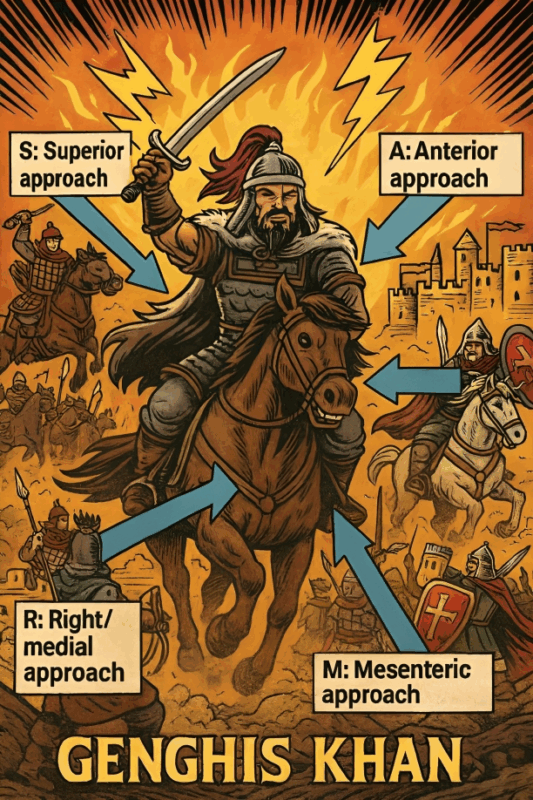
Dr Venkatesh BS: Genghis Khan and the Superior Mesenteric Artery
Dr Venkatesh BS, Transplant Surgeon at CareVue Health, posted on LinkedIn:
“Genghis Khan and The SMA”: What Pancreatic Surgery Teaches Us About Conquest
If Genghis Khan were a pancreatic surgeon, I’m convinced he’d choose to conquer the Superior Mesenteric Artery (SMA) before breakfast.
Why?
Because every major victory whether on the steppes of Eurasia or in the retroperitoneum begins with control of the battlefield.
And that, ladies and gentlemen, is exactly the philosophy behind SMA resection and reconstruction during pancreato-duodenectomy for locally advanced pancreatic cancer.
Let me explain
1. “Seize the High Ground First” → Artery-First Approaches
Genghis never marched blind into battle.
Likewise, in borderline/locally advanced disease, early SMA exposure is mandatory.
Our surgical equivalent of strategic high ground:
- Posterior (Cattell–Braasch) → flank attack
- Medial uncinate-first → central breakthrough
- Left posterior → surprise manoeuvre after fibrosis
- Mesenteric tunneling → advanced reconnaissance
Just as the Khan asked, “Is the terrain ours?”
We ask, “Is the SMA ours?”
Only then do we advance.
Otherwise… retreat. (Gracefully, without losing instruments.)
2. “Break the Enemy Line” → Precise Resection and Reconstruction
Genghis Khan believed in decisive, clean strikes.
So do we except ours involve 7-0 prolene and a lot more black coffee.
Depending on the arterial involvement, the battle plan changes:
Tangential resection + patch angioplasty
(Saphenous vein, PTFE, bovine pericardium because every empire needs good supplies)
Segmental resection + end-to-end anastomosis
Perfect when the “enemy territory” is <2 cm.
Interposition grafts
(Cadaveric iliac artery graft, auto internal iliac artery, saphenous vein)
Like calling in the cavalry when the defect is long and mobility is limited.
Key rule, just like Mongol warfare:
Tension kills. Flow wins. Precision conquers.
4. “Innovate or Vanish” → Modern Tools Genghis Would Approve
If the Khan had access to our ORs, history books would be very different.
- ICG perfusion assessment → night-time torch signaling for vessel patency
- Robotic SMA dissection → Mongol archery accuracy, but with wristed instruments
- Artery-first + venous-delay → tactical split-maneuver
- Neoadjuvant fibrosis → nature’s armor plating helping with clean margins
Even the Great Khan valued innovation.
We just replaced horses with microscopes.
4. “Victory Is Measured by What Comes After” → Outcomes That Matter
When biology cooperates and technique is uncompromising:
- Higher R0 resection rates
- Low graft thrombosis (~5%)
- Survival closer to standard resectable disease
- Quality of life preserved with meticulous reconstruction
Genghis Khan built an empire.
We aim for something smaller but more meaningful survival, margins, and function.
In pancreatic surgery, the SMA is the empire’s capital.
If you control it, the rest of the operation… surrenders.”

Stay informed with Hemostasis Today.
-
Nov 19, 2025, 18:03Andres Ricaurte Fajardo on a Strongyloides Stercoralis Hyperinfection with Thrombosis
-
Nov 19, 2025, 17:50Marilena Vrana Reflects on PPTA Europe’s Visits with Members and Stakeholders in 2025
-
Nov 19, 2025, 17:32Michael Makris Shares Insights from Global Forum Meeting of the WFH Meeting in Montreal
-
Nov 19, 2025, 17:14Yazan Abou Ismail Takes The Legacy Award from Qatar Foundation
-
Nov 19, 2025, 17:02Wolfgang Miesbach Shares Real-World Evidence on Eptacog Beta from Spain
-
Nov 19, 2025, 16:34Ishita Singh Reflects on Haematocon 2025: A Reminder of Her Commitment to The Journey
-
Nov 19, 2025, 16:23Mehdi Kashani: I’m Really Excited to Share Schistosite.com
-
Nov 19, 2025, 16:09A ”Meow-cyte” from Melaku Abay Muluneh or Why Microscopy Never Gets Old!
-
Nov 19, 2025, 15:56Cuilan Li on her Contribution to a Cutting-Edge Project in Polycythemia Vera
